AUDI A8 2012 Owners Manual
Manufacturer: AUDI, Model Year: 2012, Model line: A8, Model: AUDI A8 2012Pages: 300, PDF Size: 75.06 MB
Page 181 of 300
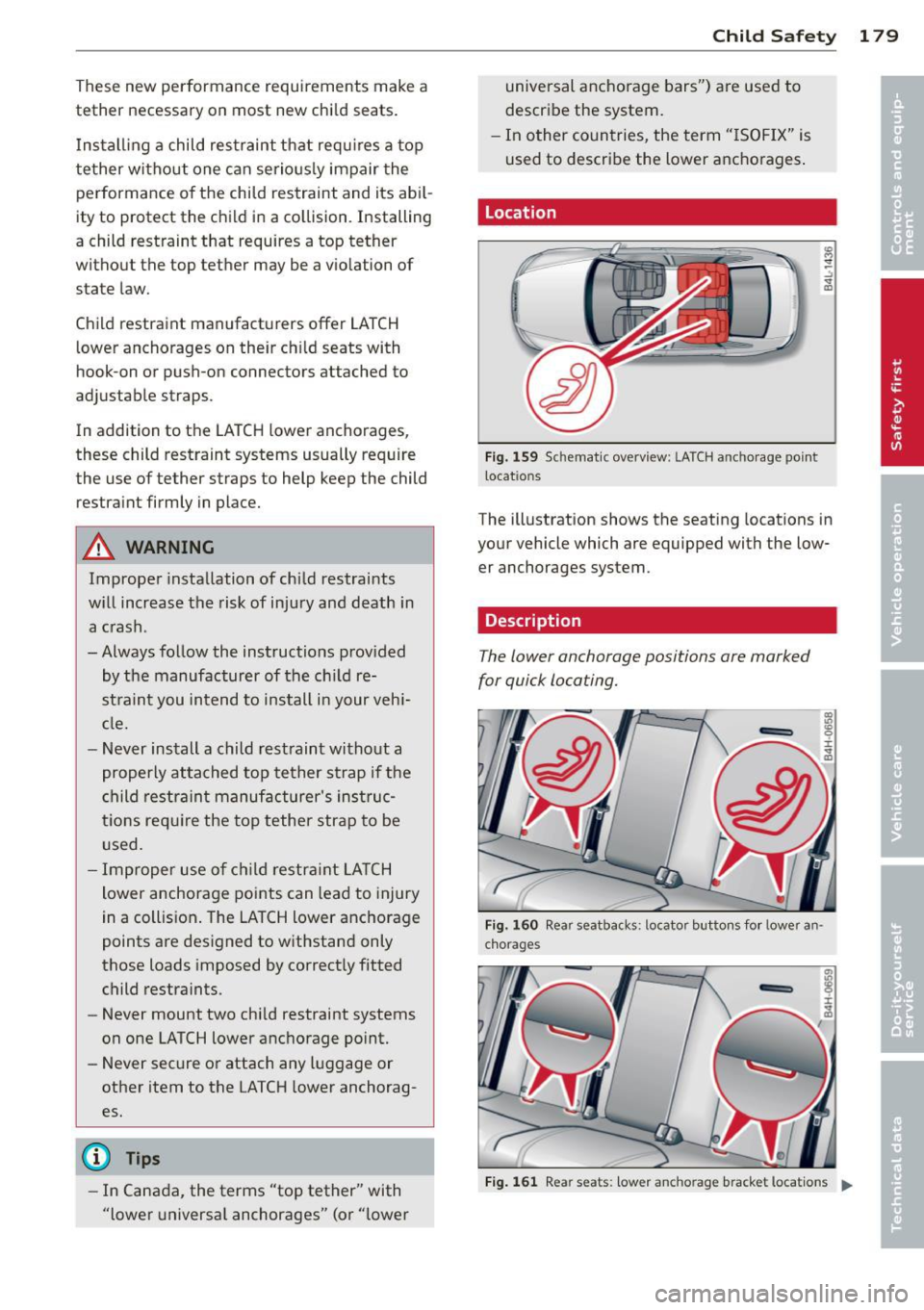
These new performance requirements make a
tethe r necessary on most new chi ld seats.
I ns tal ling a child restraint that req uires a top
tether witho ut one can serio usly impair the
performance of the child restraint and its abil
ity to protect the child i n a co llision . Installing
a child restraint that requires a top tether
wi thout the top tether may be a vio lation of
state law.
Child restraint manufacturers offer LATCH lower anchorages on the ir ch ild seats with
hook-on or push-on connectors attached to
adjustable straps.
In addition to the LATCH lower anchorages,
these child restraint systems usually require
the use of tether straps to help keep the child
restraint firmly in place.
A WARNING
Improper installation of child restraints
w ill increase the risk of injury and death in
a crash .
- Always follow the instructions prov ided
by the manufacturer of the ch ild re
st raint you intend to install in your veh i
cle.
- Never install a child restraint witho ut a
properly attached top tether s trap if the
child restrain t manufacturer's instruc
t ions requ ire the top tether strap to be
used.
- Improper use of c hild restra int LA TCH
lower anchorage points can lead to injury
in a collision . The LA TCH lower anchorage
points are des igned to w ithstand only
those loads imposed by correct ly fitted
child restraints.
- Never mount two chi ld restraint systems
on one LATCH lower anc horage point.
- Never secure o r attach any l uggage or
other item to the LATCH lower anchorag
es.
(D Tips
- In Canada, the terms "top tether" with
"lower universa l anchorages" (or "lower
-
Child S afety 1 79
universal anchorage bars") a re used to
describe the system .
- In o ther coun tries, the term " ISOFIX" is
used to describe the lower anchorages .
Location
Fig. 159 Sc hemat ic ove rv iew : LAT CH a nch orag e poin t
l ocat io n s
T he illustration shows the seating locations in
your vehicle which are equipped with the low
er anchorages system .
Description
The lower anchorage positions are marked
for quick loca ting.
Fig. 160 Rea r seat backs : locato r but tons fo r lowe r an ·
cho ra g es
r
~ I
Fi g. 1 61 Re ar seat s: low er an cho rage bra cket lo cat ion s IJI,-
Page 182 of 300
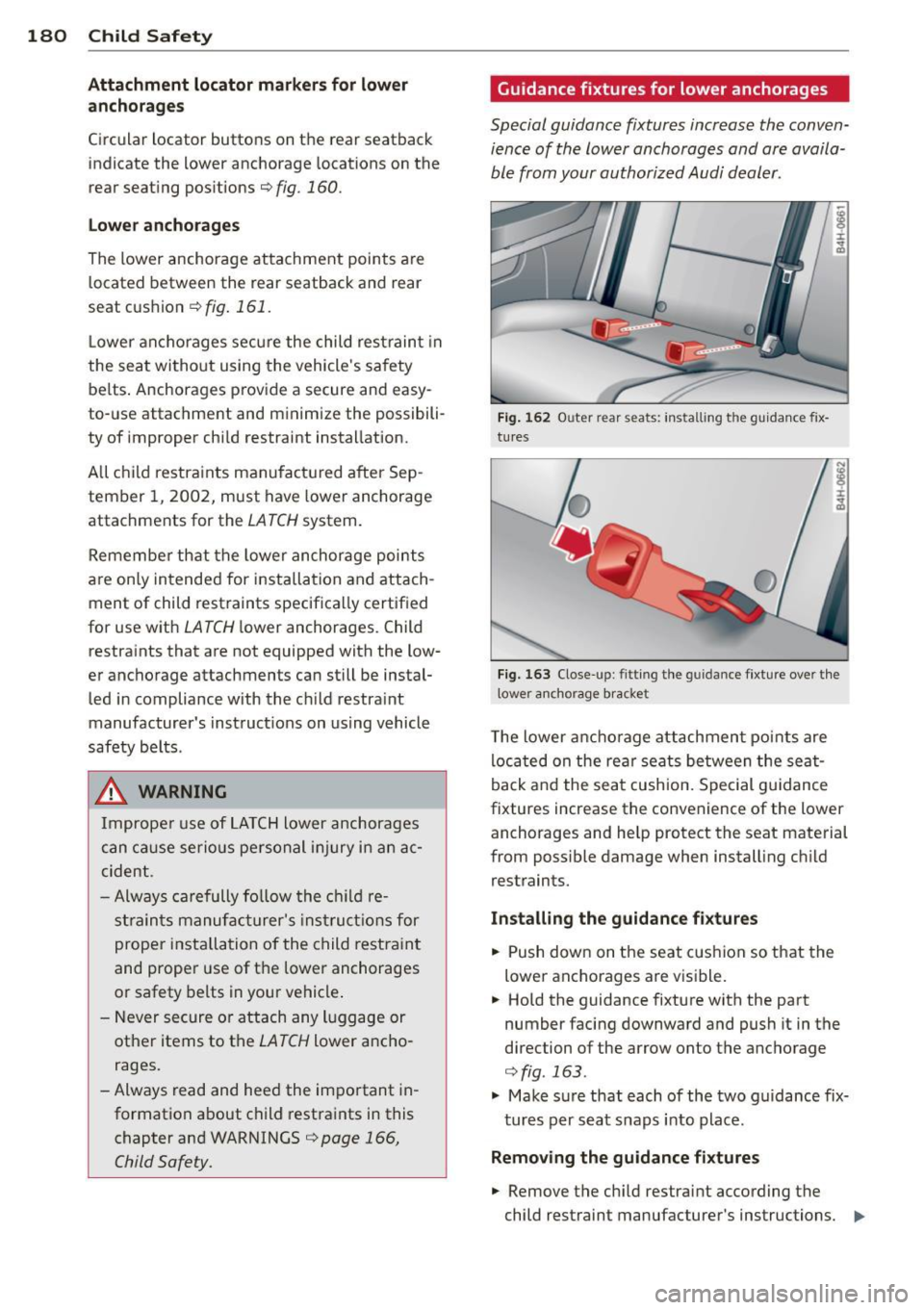
180 Child Safety
Attachment locator markers for lower
anchorages
Circular locator buttons on the rear seatback
indicate the lower anchorage locations on the
rear seating positions¢
fig. 160 .
Lower anchorages
The lower anchorage attachment points are
located between the rear seatback and rear
seat cushion
¢ fig . 161.
Lower anchorages secure the child restraint in
the seat witho ut using the vehicle 's safety
belts. Anchorages provide a secure and easy
to-use attachment and minimize the possibili
ty of improper chi ld restraint installation.
All chi ld restraints manufact ured after Sep
tember 1, 2002, must have lower anchorage
attachments for the
LATCH system.
Remember that the lower anchorage points
are only intended for installation and attach
ment of child restraints specifically certified
for use with
LATCH l ower anchorages. Child
restraints that are not equipped with the low
er anchorage attachments can still be instal led in compliance with the c hild restra int
manufacturer's instructions on using vehicle
safety belts.
,&. WARNING
Improper use of LATCH lower anchorages
can cause serious personal injury in an ac
cident .
- Always carefully follow the child re
straints manufacturer's instructions for
proper installation of the child restraint
and proper use of the lower anchorages
or safety belts in your vehicle .
- Never secure or attach any luggage or
other items to the
LATCH lower ancho
rages.
-Always read and heed the important in
formation about child restraints in this
chapter and WARNINGS
¢page 166,
Child Safety.
Guidance fixtures for lower anchorages
Special guidance fixtures increase the conven
ience of the lower anchorages and are availa
ble from your authorized Audi dealer.
Fig. 1 62 Outer rear seats: inst all ing th e guidanc e fix
tures
Fig . 163 Close-up: fitting th e g uida nce fixture over t he
lower anchorage bracket
T he lower anchorage attachment points are
located on the rear seats between the seat
back and the seat cush ion. Special guidance
fixtures increase the convenience of the lower anchorages and help protect the seat material
from possible damage when installing ch ild
restraints.
Installing the guidance fixtures
.,. Push down on the seat cushion so that the
lower anchorages are visible.
.,. Hold the guidance fixture with the part
number facing downward and push it in the
direction of the arrow onto the anchorage
¢fig . 163 .
.,. Make su re that each of the two guidance fix
tures per seat snaps into place .
Removing the guidance fixtures
.,. Remove the chi ld restraint according the
child restraint manufacturer's instructions. ..,.
Page 183 of 300
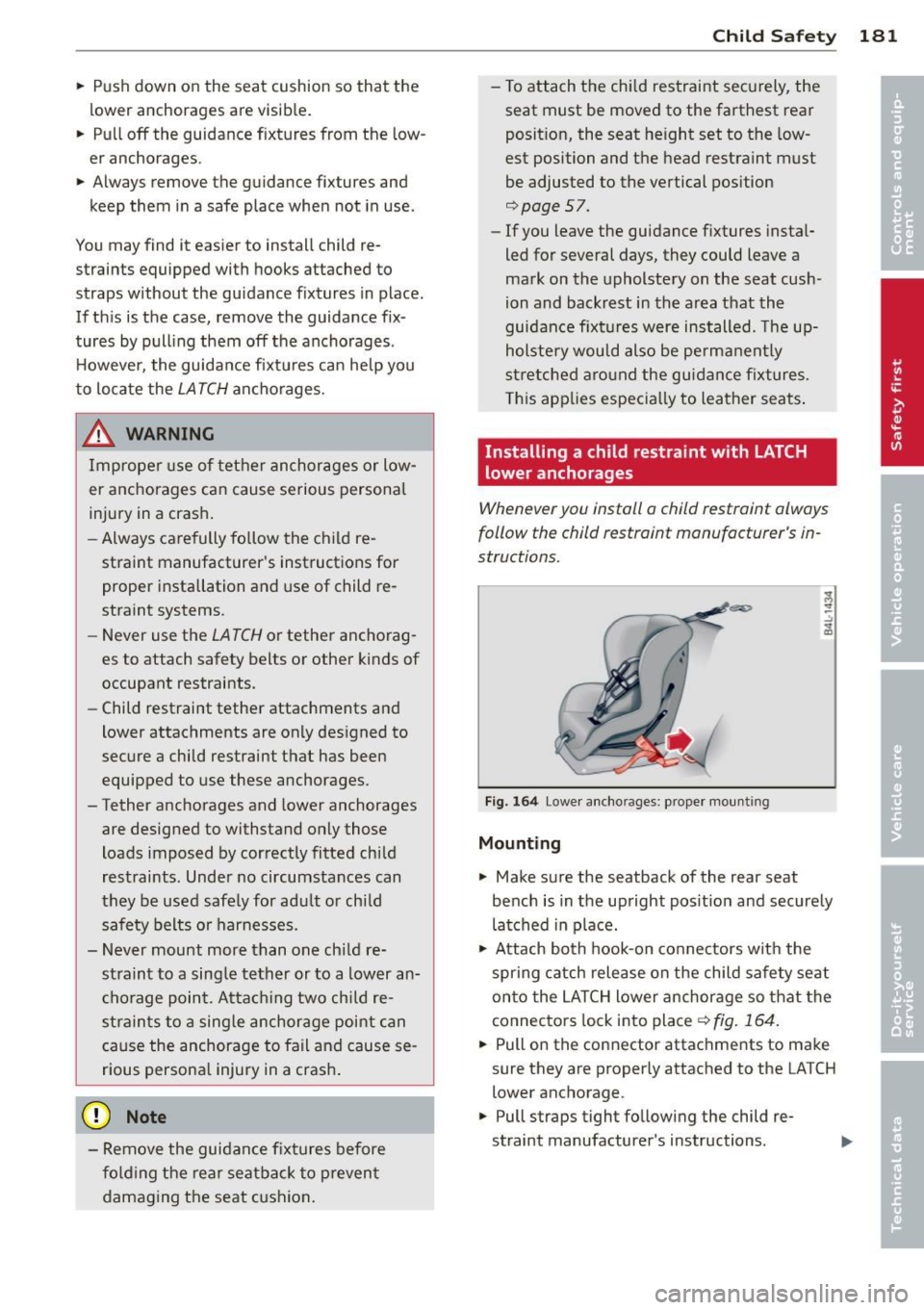
.. Push down on the seat cushion so that the
lower anchorages are visib le .
.. Pull
off the guidance f ixtures from the low
er anchorages.
.. Always remove the guidance fixtures and
keep them in a safe place when not in use .
You may find it easier to install child re
straints equipped with hooks attached to
straps without the guidance f ixtures in place.
If th is is the case, remove the guidance fix
tures by pull ing them
off the anchorages .
H owever, the guidance fixtures can help you
to locate the
LATCH anchorages.
& WARNING
Imprope r use of tether anchorages or low
er anchorages can cause serious persona l
injury in a crash .
- Always carefully fo llow the child re
straint manufacturer's instruct ions for
proper installation and use of child re
straint systems .
- Never use the
LATCH or tethe r anchorag
es to attach safety belts or other kinds of
occupant restraints.
- Child restraint tether attachments and
lower attachments are only designed to
secure a child restraint that has bee n
equipped to use these anchorages.
- Tether anchorages and lower anchorages
are designed to withstand only those
loads imposed by correctly fitted chi ld
res traints. Under no circumstances can
they be used safely for adu lt or ch ild
safety belts o r harnesses.
- Never mount more than one ch ild re
straint to a sing le te ther or to a lower an
c ho rage point. A ttaching two child re
strain ts to a single anchor age point can
cause the anchorage to fail and cause se
rious persona l injury in a crash .
(D Note
-Remove the guidance fix ture s before
fo ld ing the rea r seatback to p reven t
damag ing t he seat c ushion .
Child S afety 181
- To attach the chi ld restraint sec urely, the
seat must be moved to the farthest rear
position, the seat he ight set to the low
est position and the head restraint must
be adjusted to the vertical pos ition
9 page 57.
-If you leave the guidance fixtures instal
led for several days, they could leave a
mark on the upholstery on the seat cush
ion and back rest in the area that the
guidance f ixtures were installed. The up
holste ry would also be permanen tly
st re tched aro und the guidance fixtures.
T his app lies especia lly to leather seats .
Installing a child restraint with LATCH
lower anchorages
Whenever you install a child restraint always
follow the child restraint manufacturer's in
structions.
F ig. 164 Lowe r anchorages: prope r mount ing
Mounting
.. Make sure the seatback of the rear seat
bench is in the upright pos it ion and securely
latched in place.
.,. Attach both hook-on co nnectors wit h the
spring catch release on the child safety seat
onto the LATCH lower anchorage so that the
connectors lock into place
9 fig. 164.
.. Pull on the connector attachments to make
sure they are proper ly attached to the LATCH
lower anchorage .
.. Pull straps tight following the child re
straint manufacturer's instructions .
Page 184 of 300
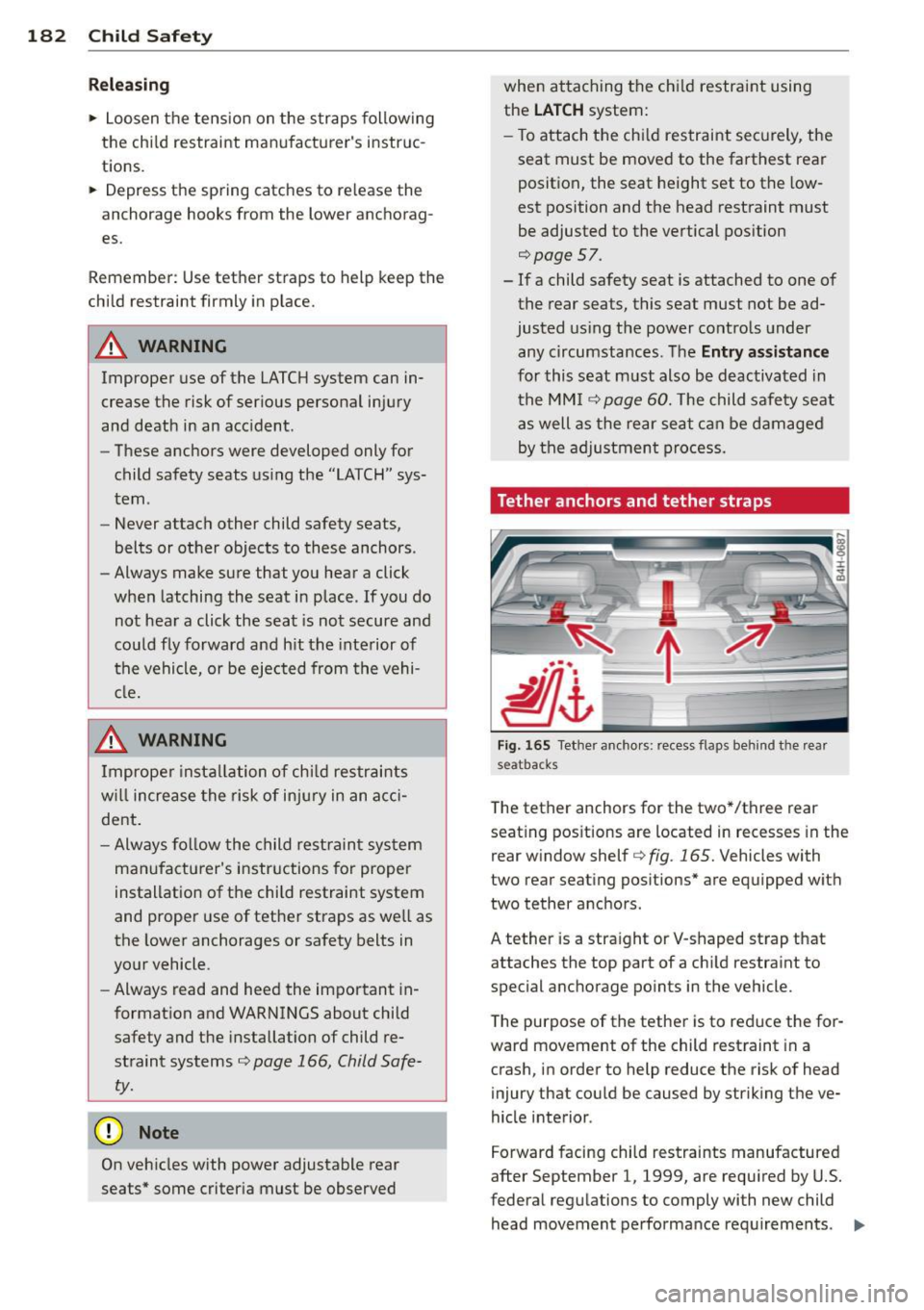
182 Child Safet y
Relea sin g
.,. Loosen the tension on the straps following
the chi ld restraint manufacturer's instruc
tions.
.,. Depress the spring catches to release the
anchorage hooks from the lower anchorag
es.
Remember: Use tether straps to help keep the
child restraint firmly in p lace.
A WARNING
Improper use of the LATCH system can in
crease the risk of serious personal injury
and death in an acc ident.
- These anchors were developed only for
child safety seats us ing the "LATCH" sys
tem .
- Never attach other child safety seats,
belts or other objects to these anchors .
- Always make sure that you hear a click
when latching the seat in place. If you do
not hear a click the seat is not secure and
could fly forward and h it the interior of
the vehicle, or be ejected from the vehi
cl e.
&_ WARNING
Imprope r insta llation of chi ld restrai nts
w ill increase the risk of inju ry in an acc i
dent.
- Always fo llow the child restraint system
man ufa cturer's instr uctions for proper
installation of the child restraint system
and proper use of tether straps as we ll as
the lower anchorages or sa fety belts in
your vehicle .
- Always read and heed the important in
format ion and WARNINGS about child
safety and the installation of child re
straint systems
c:> page 166, Child Safe
ty.
(D Note
On veh icles with p ower adjustable rear
seats* some criteria must be observed when attaching the chi
ld restraint using
the
LATCH system:
- T o attach t he ch ild restraint sec urely, the
seat must be moved to the farthest rear
posit ion, the seat he ight set to the low
est position and the head restraint must
be adjusted to the vertical position
c:>page 57.
- If a child safety seat is attached to one of
the rear seats, this seat must not be ad
justed us ing the power controls under
any c ircumstances . T he
Entry as sistanc e
for this seat must also be deactivated in
the MM I
c:> page 60. The child safety seat
a s well as the rear se at can be damaged
by the adj ustment process .
Tether anchors and tether straps
Fig. 1 65 Tet her ancho rs: recess flaps behind th e rea r
seatbacks
T he tether anchors for the two* /three rear
seat ing positions are located in recesses in the
rear w indow shelf
c:> fig . 165. Vehicles with
two rear seating positions* are equipped wit h
two tether anchors .
A tether is a stra ight or V-shaped strap that
attaches the top part of a ch ild restra int to
special anchorage po ints in the vehicle.
T he purpose of the tether is to reduce the for
ward movement of the child restraint in a crash, in order to help reduce the risk of head
injury that could be caused by strik ing t he ve
hicle interior .
Forward facing child restraints manufactured
after September 1, 1999, are requ ired by U.S.
federal regulations to comply with new child
head movement performance requirements . .,..
Page 185 of 300
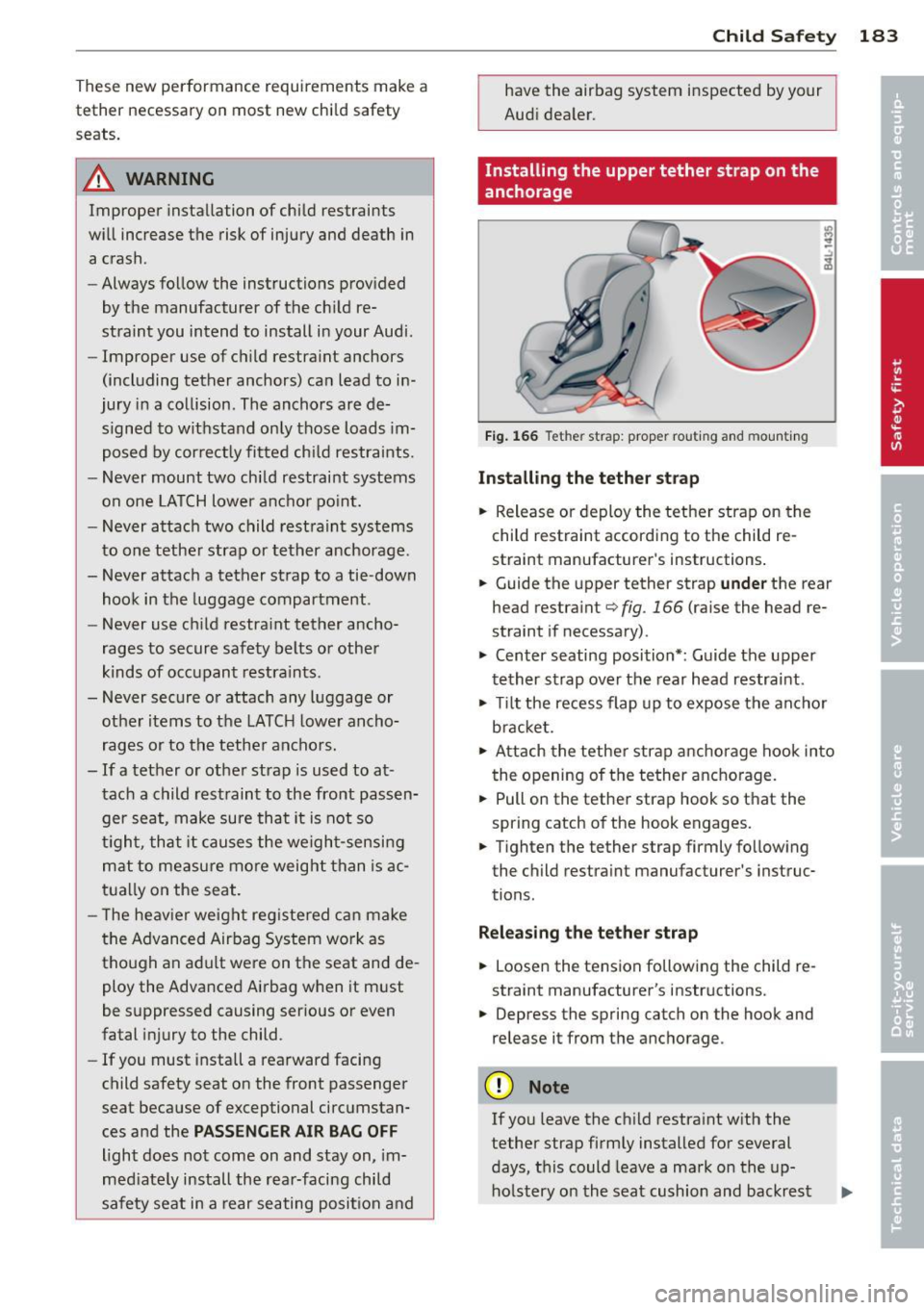
These new performance requirements make a
tether necessary on most new chi ld safety
seats.
.&_ WARNING
Improper installation of child restraints
will increase the risk of injury and death in a crash.
- Always follow the instructions provided
by the manufacturer of the ch ild re
straint you intend to install in your Audi.
- Improper use of c hild restraint anchors
(including tether anchors) can lead to in
jury in a collision. The anchors are de
signed to withstand only those loads im
posed by correctly fitted ch ild restraints.
- Never mount two chi ld restraint systems
on one LATCH lower anc hor po int.
- Never attach two child restraint systems
to one tethe r strap or tether anchorage.
- Never attach a tether strap to a tie-down
hook in the luggage compartment .
- Never use child restraint tether ancho
rages to secure safety belts or other
k inds of occ upant restra ints.
- Never secure or attach any luggage or other items to the LATCH lowe r ancho
rages or to th e tethe r ancho rs.
- If a tether or other strap is used to at tach a child restraint to the front passen
ger seat, make sure that it is not so
t ight, that it causes the weight -sensi ng
mat to measu re mo re weight than is ac
t u a lly on the seat.
- T he he avier weig ht reg iste red ca n make
the Advanced Airbag Sys tem work as
tho ugh an adult were on the seat and de
ploy the Advanced Airbag w hen it must
be s uppressed causing serious or
even
fatal injury to the child .
- If you must install a rearward facing
child safety seat on the front passenger
seat because of exceptional circumstan
ces and the
PASS ENG ER AIR BAG OFF
light does not come on and stay on, im
med iate ly install the rear-facing chi ld
safety seat in a rear seating posit ion a nd
-
Child S afety 183
have the airbag system inspected by your
Aud i dealer.
Installing the upper tether strap on the
anchorage
F ig . 1 66 Tet her st rap: proper ro uting and mounting
Installing the t eth er strap
.. Release or deploy the tether strap on the
child restraint according to the child re
straint manufacturer's instructions.
.. Guide the upper tether strap
unde r the rear
head restra int
qfig. 166 (ra ise the head re
straint if necessa ry) .
.. Center seating position*: Guide the upper
tether strap over the rear head restra int .
.. Til t the recess flap up to expose the an chor
bra cket.
.. Attach the tether strap anchorage hook into
the opening of the tether ancho rage .
.. Pull on the tether strap hook so that the
spring catch of the hook engages .
.. Tighten the tether strap firmly follow ing
the child restraint manufacturer's instruc
tions .
Relea sing the tether strap
.. Loosen the tension following the child re
straint manufacturer's instructions.
.. Depress the spring catch on the hook and
release it from the anchorage .
Q) Note
If you leave the child restraint w ith the
tether strap firmly installed for several
days, t his could leave a mark on the up
ho lstery o n the seat cushion and backrest
Page 186 of 300
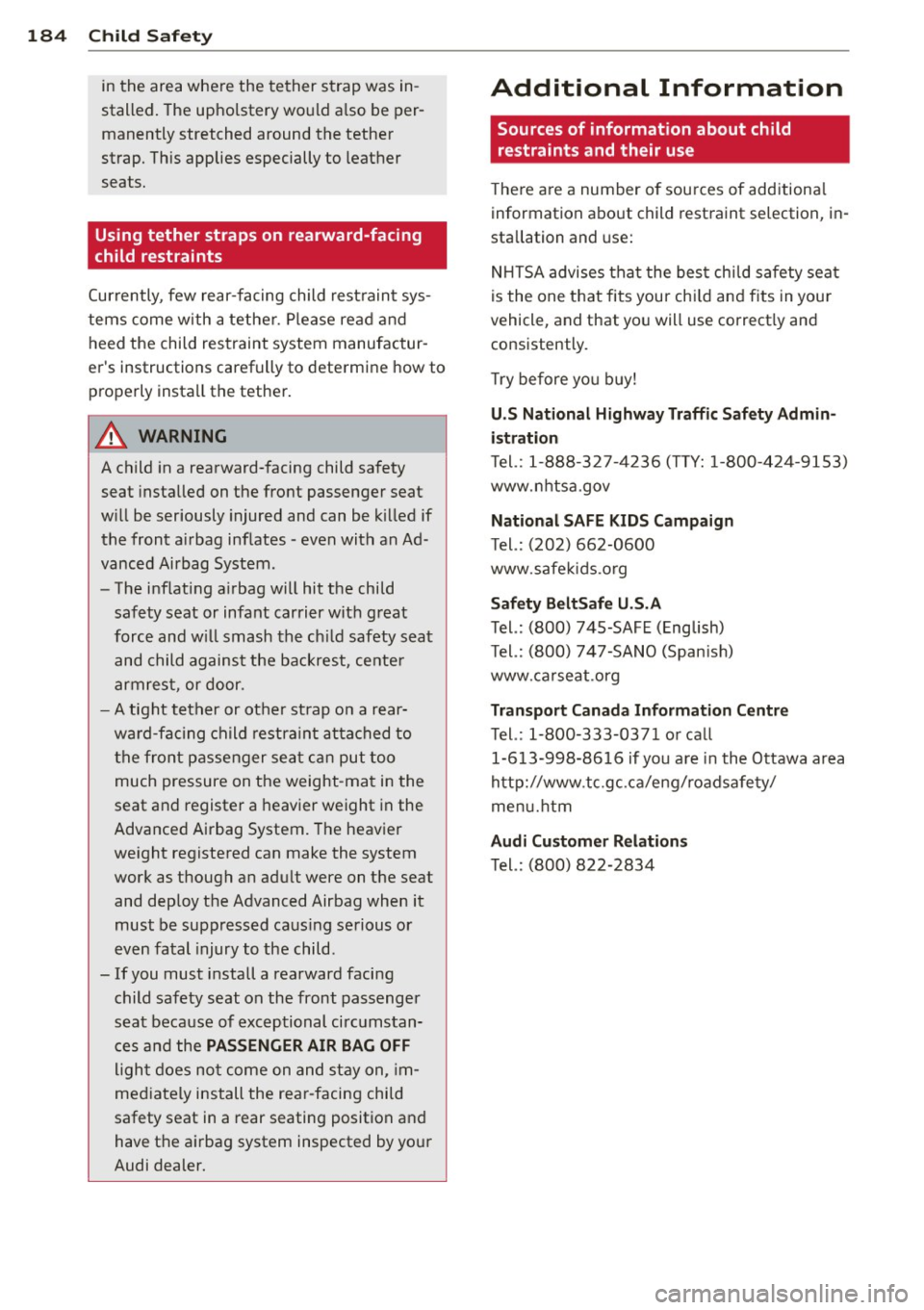
184 Child Saf ety
in the area whe re the tether strap was in
stalled. The upholstery would a lso be per
manently stretched around the tether
strap. This applies especially to leather
seats.
Using tether straps on rearward-facing
child restraints
Currently , few rear-facing child rest rain t sys
tems come with a tether. P lease read and
heed the child restraint system manufactur
er's instructions carefully to determine how to
properly install the tether .
A WARNING
A child in a rearward -facing child safety
seat installed on the front passenger seat
w ill be seriously injured and can be k illed if
the front a irbag inflates -even with an Ad
vanced Airbag System .
- The inflating a irbag will hit the child
safety seat or infant carrier with great
force and w ill smash the ch ild safety seat
and child against the backrest, cente r
armrest, or door.
- A tight tet her or ot her st rap on a rear
wa rd-fa cing child restra int attached to
the front p assenger sea t ca n put too
much pressure on the weight -ma t in the
seat and register a heavier weight in the
Advanced Airbag System. The heavier
we ight registered can make the system
work as though an adu lt were on the seat
and dep loy the Advanced Airbag when it
must be suppressed ca using se rious or
even fatal injury to the child .
- If you must install a rearward facing child safety seat on the front passenger
seat because of exceptional circ umstan
c es and the
PASSENGER AIR BAG OFF
ligh t does no t come on and stay on, im
med iately install the rear -facing child
safety seat in a rear seating position and
have the a irbag system inspected by yo ur
Audi dealer.
Additional Information
Sources of information about child
restraints and their use
T he re a re a number o f sou rces of add itiona l
information abo ut child rest raint se lection, in
sta llation and use:
N HT SA advises that the bes t ch ild safety seat
is the one that fits your ch ild an d fits in you r
vehicle, and that yo u will use correct ly and
consistently .
T ry before yo u buy!
U.S National Highway Traffic Safety Admin
i s tration
T el.: 1-888-3 27-4 236 (TIY: 1-800- 424-9153)
www.n htsa.gov
National SAFE KIDS Campaign
T el.: (202) 662-0600
www.safe kids.o rg
Safety BeltSaf e U.S .A
Tel.: (800) 745-SAFE (English)
Te l.: (800) 7 47-SANO (Span is h)
www. carseat .org
Transport Canada Information C entre
Tel.: 1-800-333-0371 o r call
1-6 13-998-86 16 if you a re i n the Ottawa area
http://www.tc.gc.ca/e ng/ roadsafe ty/
men u.h tm
Audi Cu stomer R elation s
Tel.: (800) 822-2834
Page 187 of 300
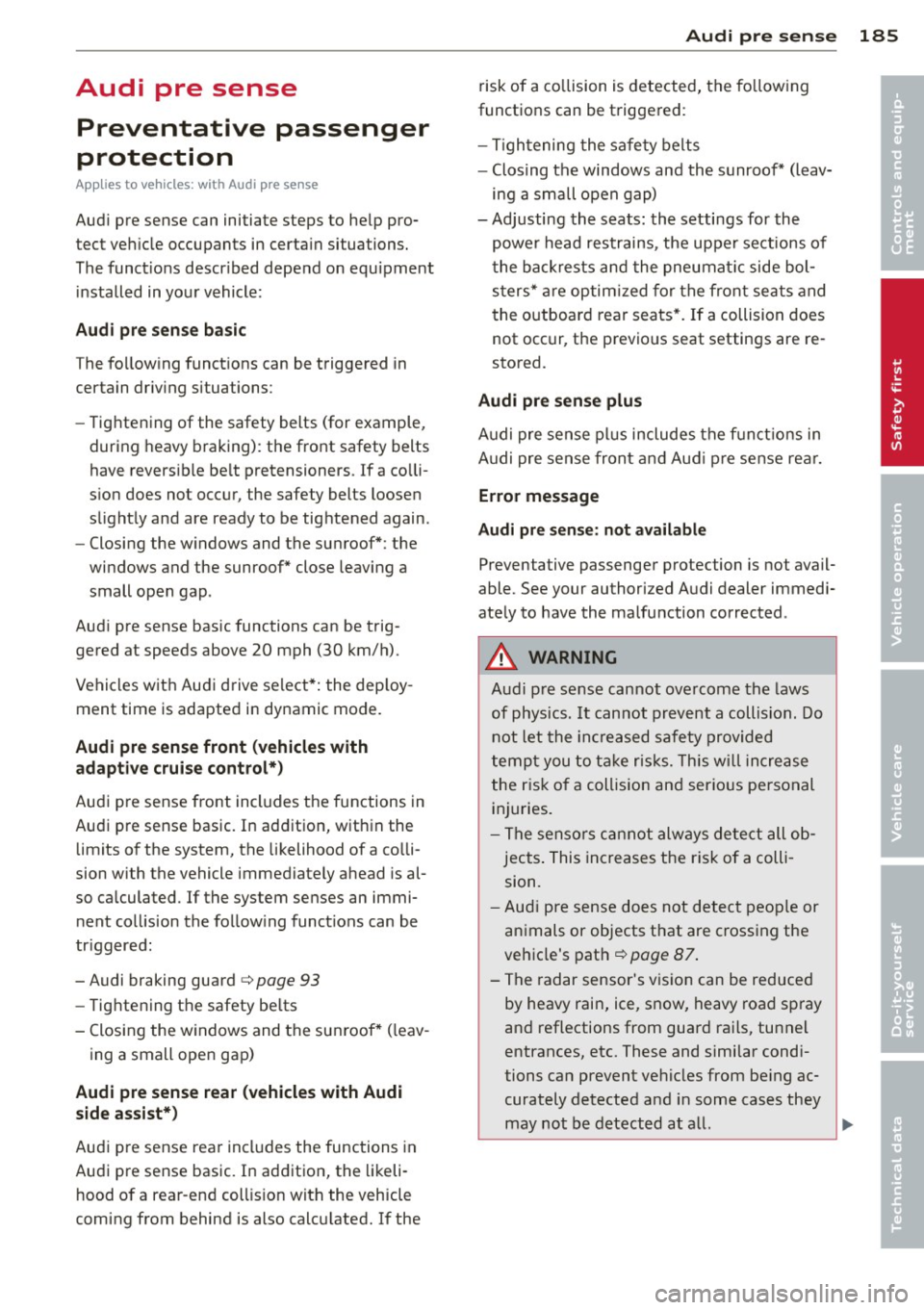
Audi pre sense Preventative passenger
protection
App lies to veh icles: with Audi p re se nse
Audi pre sense can initiate steps to help pro
tect vehicle occupants in certain situations.
The funct ions descr ibed depend on equipment
installed in your vehicle:
Audi pre sense basic
The following functions can be triggered in
certain driving situations:
- Tightening of the safety belts (for example,
during heavy braking) : the front safety belts
have reversible belt pretensioners. If a colli
sion does not occur, the safety belts loosen
slightly and are ready to be tightened again.
- Closing the windows and the sunroof*: the
windows and the sunroof" close leaving a
small open gap .
Audi pre sense basic functions can be trig
gered at speeds above 20 mph (30 km/h).
Vehicles with Audi drive select*: the deploy
ment time is adapted in dynamic mode.
Audi pre sense front (vehicles with
adaptive cruise control*)
Audi pre sense front includes the functions in
Audi pre sense basic. In addition, within the
limits of the system, the likelihood of a colli
sion with the vehicle immediately ahead is al
so calculated . If the system senses an immi
nent collision the following functions can be
tr iggered:
- Audi braking guard
c> page 93
-Tightening the safety belts
- Closing the windows and the sunroof* ( leav-
ing a small open gap)
Audi pre sense rear (vehicles with Audi
side assist*)
Audi pre sense rear includes the functions in
Audi pre sense basic. In addition, the likeli
hood of a rear-end col lision with the vehicle
coming from behind is also calculated. If the
Audi pre sense 185
risk of a collision is detected, the following
functions can be triggered:
- Tightening the safety belts
- Closing the windows and the sunroof* (leav-
ing a small open gap)
- Adjusting the seats: the settings for the
power head restrains, the upper sections of
the backrests and the pneumatic side bol
sters* are optim ized for the front seats and
the outboard rear seats*. If a collision does
not occur, the previous seat settings are re
stored.
Audi pre sense plus
Audi pre sense plus includes the funct ions in
Audi pre sense front and Audi pre sense rear.
Error message
Audi pre sense: not available
Preventative passenger protection is not avail
able. See your authorized Audi dealer immedi
ately to have the malfunction corrected .
A WARNING
Audi pre sense cannot overcome the laws
of physics.
It cannot prevent a collision. Do
not let the increased safety provided
tempt you to take risks. This will increase
the risk of a collision and serious personal
injuries.
- The sensors cannot always detect all ob
jects . This increases the risk of a colli
sion.
-Audi pre sense does not detect people or
animals or objects that are crossing the
veh icle's path
c> page 87.
- The radar sensor's vision can be reduced
by heavy rain, ice, snow, heavy road spray
and reflections from guard rails, tunnel
entrances, etc. These and similar condi
tions can prevent vehicles from be ing ac
curately detected and in some cases they
may not be detected at all.
Ill-
•
•
Page 188 of 300

186 Audi pre sen se
The sensors can be displaced by impacts or
damage to the bumper, whee l housing and
underbody. This can affect the function of
the Audi pre sense system. Have your au
thorized Audi dealer check to make sure
that the system is working properly .
@ Tips
-Certain Audi pre sense functions are not
available when ASR is sw itched off (sport
mode) or w hen driv ing in reverse.
- The Audi pre sense functions may not be
available if there is a malfunction in the
ESC system or the airbag control mod
ule.
- The Audi pre sense front/plus functions
are not available if the re is a ma lfunction
i n the adapt ive cru ise control* system
¢page 94.
- The Audi pre sense rear/plus functions
are not available if there is a ma lfunction
i n the Aud i side assis t* system
¢ page 94 .
Page 189 of 300
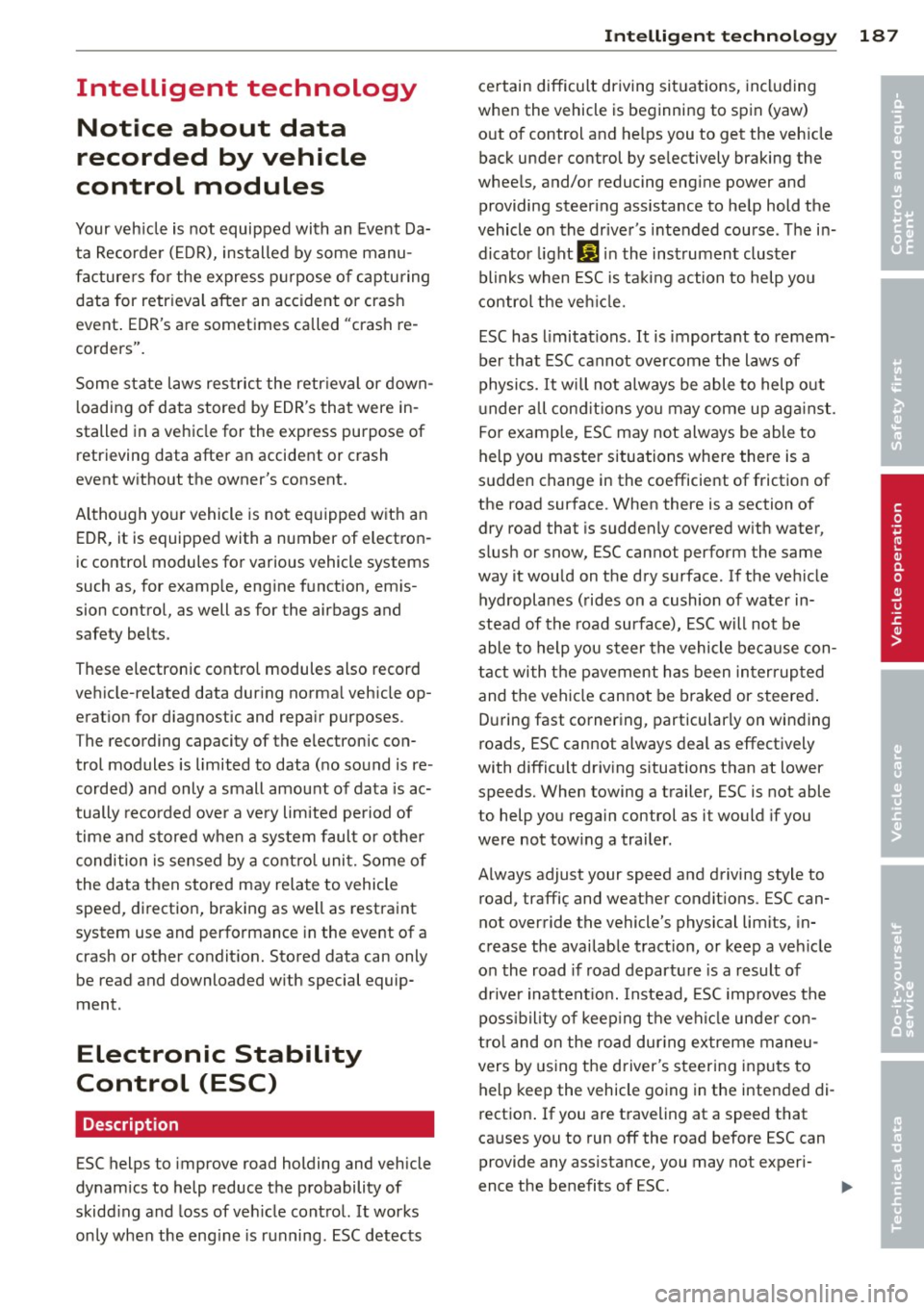
Intelligent technology Notice about data
recorded by vehicle
control modules
Your vehicle is not equipped with an Event Da
ta Recorder (EDR), installed by some manu
facturers for the express purpose of capturing
data for retrieval after an accident or crash
event. EDR's are sometimes called "crash re
corders".
Some state laws restrict the retr ieval or down
loading of data stored by EDR's that were in
stalled in a vehicle for the express purpose of
retrieving data after an accident or crash
event without the owner's consent.
Although your vehicle is not equipped with an
EDR, it is equipped with a number of electron
ic control modules for various vehicle systems
such as, for examp le, engine function, emis
sion control, as well as for the airbags and
safety belts.
These electronic control modules also record
vehicle-related data during norma l vehicle op
eration for diagnostic and repair purposes.
The recording capacity of the electronic con
trol modules is limited to data (no sound is re
corded) and only a small amount of data is ac
tually recorded over a very limited period of
time and stored when a system fault or other
condition is sensed by a control unit. Some of
the data then stored may relate to vehicle
speed, direction, braking as we ll as restraint
system use and performance in the event of a
crash or other condition. Stored data can only be read and downloaded with special equip
ment.
Electronic Stability
Control (ESC)
Description
ESC helps to improve road holding and vehicle
dynamics to help reduce the probability of
skidding and loss of veh icle control. It works
only when the engine is running. ESC detects
Intelligent technology 187
certain difficult driving situations, including
when the vehicle is beginning to spin (yaw)
out of control and helps you to get the veh icle
back under control by se lectively braking the
wheels, and/or reducing engine power and
providing steering ass istance to help hold the
vehicle on the driver's intended course. The in
dicator light
Ip.] in the instrument cluster
blinks when ESC is taking action to help you
control the vehicle.
ESC has limitations .
It is important to remem
ber that ESC cannot overcome the laws of
physics.
It will not always be able to help out
under all conditions you may come up against.
For example, ESC may not always be able to
help you master situations where there is a
sudden change in the coefficient of friction of
the road surface. When there is a section of
dry road that is suddenly covered with water,
slush or snow, ESC cannot perform the same
way it would on the dry surface . If the vehicle
hydroplanes (rides on a cushion of water in
stead of the road surface), ESC will not be
able to help you steer the vehicle because con
tact with the pavement has been interrupted
and the vehicle cannot be braked or steered .
During fast cornering, particularly on winding
roads, ESC cannot always deal as effectively
with difficult driving situations than at lower
speeds. When towing a trailer, ESC is not able
to help you regain control as it would if you
were not tow ing a trailer.
Always adjust your speed and driving style to road, traffi<; and weather conditions. ESC can
not override the vehicle's physical limits, in
crease the available traction, or keep a veh icle
on the road if road departure is a result of
driver inattention. Instead, ESC improves the
poss ibility of keeping the vehicle under con
trol and on the road dur ing extreme maneu
vers by using the driver's steering inputs to
help keep the vehicle going in the intended di
rection. If you are traveling at a speed that
causes you to run off the road before ESC can
provide any assistance, you may not experi
ence the benefits of ESC.
•
•
Page 190 of 300
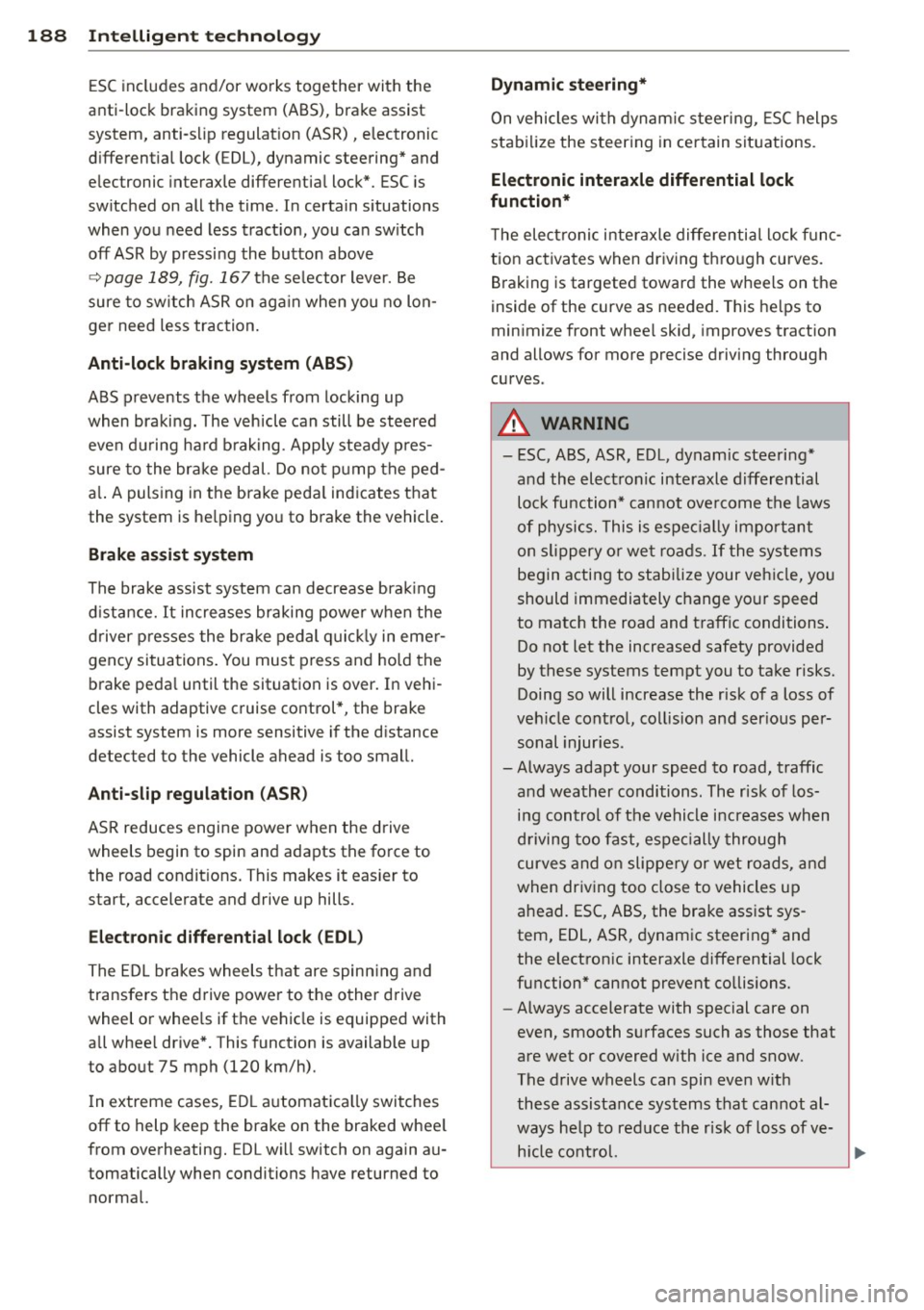
188 Intelligent technology
ESC includes and/or works together with the
anti-lock braking system (ABS), brake assist
system, anti-s lip regulat ion (ASR), e lectronic
d ifferential lock ( EDL), dynamic steering* and
e lectronic interaxle differentia l lock*. ESC is
switched on all the time. I n certa in s ituations
when you need less tract io n, you ca n sw itch
off ASR by pressi ng the button above
~ page 189, fig. 167 the se lector lever. Be
sure to sw itch ASR on ag ain when you no lon
ger need less trac tion.
Anti -lock braking system (ABS)
ABS prevents t he wheels from locking up
when braking. The veh icle can still be st eered
even d uring ha rd b rak ing . Apply steady p res
sure to the br ake ped al. Do no t pu mp the ped
a l. A puls ing in t he bra ke peda l ind icates that
the system is he lping yo u to b rake the vehicle .
Brake assist system
The brake assist system can decrease b ra kin g
d ista nce. It increases braking powe r w hen the
d river p resses the brake pedal quickl y in eme r
gency situa tions . You mus t press and ho ld the
b rake peda l until the situation is over. In vehi
cles with adaptive cruise control*, the brake
assist system is more sensitive i f the d istance
detected to the vehicle ahead is t oo smal l.
Anti-slip regulation (ASR)
ASR reduces engine power w hen the drive
wheels begin to spin and adapts the fo rce to
the road condit ions. This makes it eas ier to
start, accelerate and drive up hills.
Electronic differential lock (EDL )
The E DL brakes wheels that are spinn ing and
transfers the drive powe r to the o ther d rive
wheel o r whee ls if the vehic le is equipped with
a ll whee l drive*. This funct ion is available up
to about 7S mph (120 km/h).
I n extreme cases , EDL automatica lly swit ches
off to help keep the brake on the braked whee l
from overheating. ED L wi ll switch on again au
tomatically when conditions have returned to normal.
Dynamic steering*
On vehicles wi th dynam ic s teeri ng, ES C helps
stab ilize the steer ing in cer tain sit uations.
Electronic interaxle differential lock
function*
T he ele ctronic i nte raxle di fferentia l lock f unc
tion ac tiva tes when dr iving t hrough curves.
B ra king is targeted towar d the whee ls on the
inside of the curve as needed . This helps to
min imi ze front whee l skid, improves traction
and allows for more precise driving throug h
cu rves .
A WARNING
- ESC, ABS, ASR , EDL, dynamic steering*
and the elect ronic interaxle differential
loc k function* cannot ove rcome t he laws
of physics . This is espe cially im po rtant
on slippery o r we t road s.
If the sys tems
begin actin g to stabilize your veh icle, you
should immediately change yo ur speed
to match the road and t raffic conditions .
Do not let the increased safety provided
by these systems tempt you to take risks. Doing so will increase the risk of a loss of
veh icle cont ro l, collision and ser io us per
sonal injur ies .
-Always ada pt your speed to road , traffic
and wea ther conditions. The risk of los
ing contr ol of the vehicle i ncreases wh en
d riving too fast, espe cially through
curve s and on slippe ry or wet roads, and
when dr iv ing too close to vehicles up
ahead. ESC, ABS, the brake ass ist sys
tem, EDL, ASR, dynam ic steering * and
the elect ron ic interaxle differential lock
function * cannot prevent co llisions.
- Always accelerate with s pecial care on
even, smooth s urfaces such as those that
are wet or covered with ice and snow.
The drive wheels can spin even w ith
these assistance sys tems that cannot al
ways he lp to red uce the risk of loss of ve
h icle co nt ro l.
-